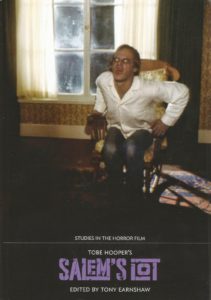 Edited By TONY EARNSHAW (Centipede Press; 2013)
Edited By TONY EARNSHAW (Centipede Press; 2013)
Another entry in Centipede Press’ “Studies in the Horror Film” series, which includes book-length explorations of THE SHINING, THE EXORCIST, PAN’S LABYRINTH and other iconic horror flicks. This one focuses on the Stephen King adapted 1979 TV miniseries SALEM’S LOT, and is, like the rest of the series, quite enjoyable for fans of the film. (People who aren’t fans of SALEM’S LOT probably won’t get much out of this book, but then I strongly doubt such folk will bother picking it up at all.)
SALEM’S LOT, I feel, is one of the best Stephen King adaptations, and certainly one of the finest films ever directed by the late Tobe Hooper. It suffers from slack pacing and a lot of evident padding (with too many shots of people getting in and out of cars and/or crossing streets), but is quite strong overall, with uniformly skilled performances, striking location work (it was filmed in Ferndale, CA, standing in, quite convincingly, for Maine) and one of the most authentically frightening images in horror movie history: the depiction of the grinning vampire boy floating in midair outside the window of his still-living brother.
This book includes a lot of info about that scene, which was achieved, we learn, via a crane attached to the actor, who played his part in reverse. We also learn about the cinematography, courtesy of an interview with the film’s director of photography Jules Brenner, and also its score, via an interview with the daughter of the late composer Harry Sukman. The film’s lead actors David Soul, James Mason, Lance Kerwin and Geoffrey Lewis also give their thoughts on SALEM’S LOT and its legacy, as do Tobe Hooper (who’s quoted as saying “This is the most time I’ve ever spent talking about SALEM’S LOT”) and producer Richard Kobritz, who was responsible for hiring Hooper and, it seems, was the true driving force behind the production of SALEM’S LOT.
Rounding things out are a 1979 Famous Monsters of Filmland interview with Stephen King, in which he gives his thoughts on the film (apparently “One of the best horror films that has ever been made for television”) and its departures from his source novel (about which, as you might guess, he wasn’t too pleased), and several articles and interviews from volume 9 of Cinefantastique (which until the appearance of this book was the definitive print resource on the film). There’s also a generous selection of stills, promotional artwork, then-and-now location photographs and about 35 photocopied pages of the film’s shooting script, ensuring that every conceivable aspect of the production of SALEM’S LOT is covered.
